| Columns Retired Columns & Blogs |
Musical Fidelity M6DAC D/A processor Measurements
Sidebar 3: Measurements
I examined the Musical Fidelity M6DAC's electrical performance with Stereophile's loan sample of the top-of-the-line Audio Precision SYS2722 system (see www.ap.com and the January 2008 "As We See It"); for some tests, I also used my vintage Audio Precision System One Dual Domain. The TosLink input locked to datastreams with sample rates up to 96kHz; the coaxial, AES/EBU, and USB inputs all worked with data sampled at rates up to 192kHz, including 88.2 and 176.4kHz. The Macintosh USB Prober utility revealed that the M6DAC's USB 2.0 input does operate in the specified asynchronous mode with 24-bit data.
The maximum output level at 1kHz was 4.05V from the balanced XLR jacks, 2.01V from the single-ended RCAs. Both pairs of outputs preserved absolute polarity (ie, were non-inverting). The XLRs are wired with pin 2 hot. The output impedance at middle and high frequencies was a low 48 ohms from the single-ended jacks, 96 ohms from the XLRs. Though these values rose to 77 and 188 ohms at the bottom of the audioband, implying the existence of coupling capacitors somewhere in the signal path, this will have no effect on bass performance.
The M6DAC offers a choice of two reconstruction filters, labeled Slow Roll Off and Fast Roll Off. Fig.1 shows the impulse response at 44.1kHz of the Fast filter; curiously, the impulse response of the Slow filter was identical. Usually, a slow-rolloff filter sacrifices some stopband attenuation to give better time-domain performance. (See my Follow-Up on the Arcam FMJ D33 in the April issue, p.180, for a discussion of this subject.)
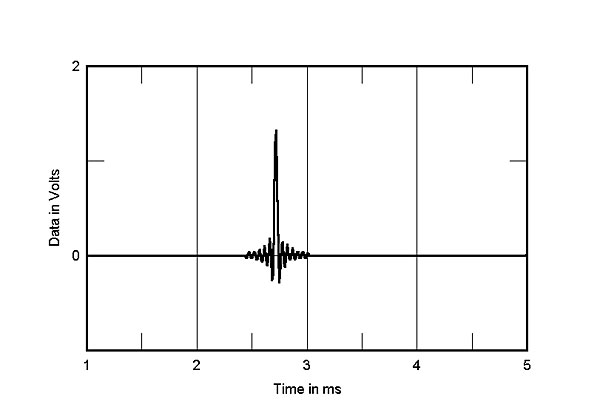
Fig.1 Musical Fidelity M6DAC, impulse response with Fast filter (4ms time window).
To investigate further, I first fed the M6DAC with 44.1kHz data representing white noise, then data representing a 19.1kHz tone at 0dBFS. The white noise exposes the rolloff nature of the reconstruction filter; the tone reveals the filter's rejection of ultrasonic images. Fig.2 shows the spectrum of the Musical Fidelity's analog output using these test signals and the Fast filter. The white noise (blue trace) shows that the filter does indeed roll off quickly, reaching the noise floor at 24kHz. But while some low-level distortion components can be seen with the 19.1kHz tone (red trace), nothing is visible at the aliasing frequency of 25kHz. Fig.3 shows the spectrum with the Slow filter—identical! It's no wonder I could hear no differences between these filters; their behavior with 44.1kHz material is identical in both the time and frequency domains.
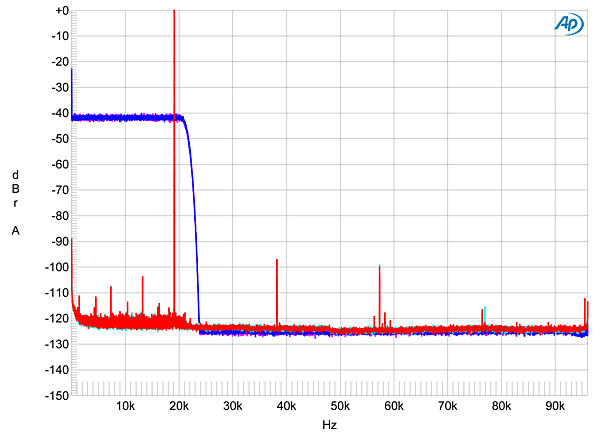
Fig.2 Musical Fidelity M6DAC, Fast filter, wideband spectrum of white noise at –4dBFS (left channel blue, right magenta) and 19.1kHz tone at 0dBFS (left cyan, right red), with data sampled at 44.1kHz (10dB/vertical div.).
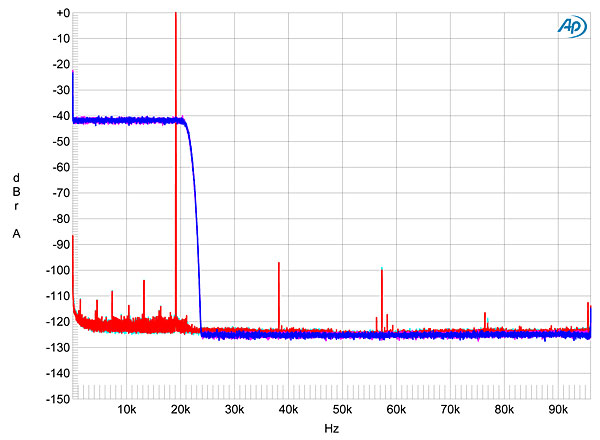
Fig.3 Musical Fidelity M6DAC, Slow filter, wideband spectrum of white noise at –4dBFS (left channel blue, right magenta) and 19.1kHz tone at 0dBFS (left cyan, right red), with data sampled at 44.1kHz (10dB/vertical div.).
Concerned that the review sample of the M6DAC was faulty, I let Musical Fidelity know of my findings. Their response was that, no, that is how these filters are supposed to behave. In the M6DAC's block diagram, the reconstruction filter follows the section that upsamples the data to 192kHz, so the difference between the two filters will be measurable only with 192kHz data. I therefore generated a white-noise file with a sample rate of 192kHz and repeated the spectral analysis, extending the bandwidth to 108kHz. The result is shown in fig.4: the Slow filter (blue, magenta traces) does indeed roll off sooner than the Fast filter (cyan, red). But as both are flat to well above 60kHz, the differences between the two filters are moot.
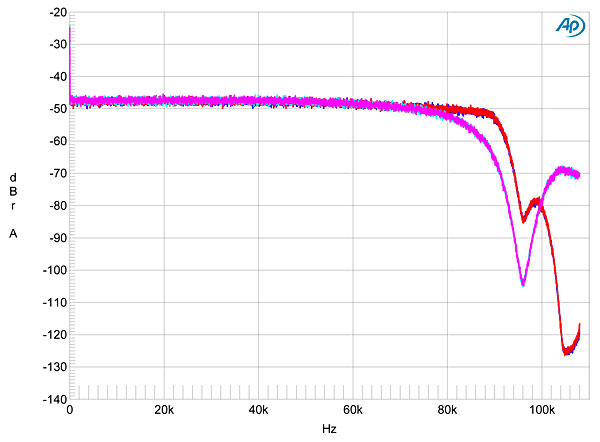
Fig.4 Musical Fidelity M6DAC, wideband spectrum of white noise at –4dBFS with data sampled at 192kHz, with Fast (left channel blue, right red) and Slow (left cyan, right magneta) filters (10dB/vertical div.).
I was puzzled by this, as there seems little point in offering a choice of filters that actually provides no choice in the audioband with 44.1kHz-sampled data. DACs like those from Arcam, Ayre, and dCS offer the user choices among reconstruction filters that are audibly and measurably different. Further correspondence with Musical Fidelity revealed that, rather than use a reconstruction filter realized in an FPGA chip, as do the three other manufacturers named, they simply switch between the on-chip digital filters provided by Burr-Brown's DSD1796 DAC. And as the M6DAC runs this DAC chip at a constant 192kHz sample rate, this explains why I found no meaningful differences between these two filters at all sample rates, up to and including 176.4kHz.
Fig.5 shows the M6DAC's frequency response with the Fast filter at sample rates of 44.1kHz (green, gray traces), 96kHz (cyan, magenta), and 192kHz (blue, red). At the two lower rates, a small degree of passband ripple is followed a steep rolloff just below the Nyquist frequency (half the sample rate), with excellent matching between channels. At 192kHz, the smooth rolloff reaches –3dB at 80kHz. Channel separation (not shown) was superb, at >120dB in both directions below 3kHz, and still 113dB at the top of the audioband.
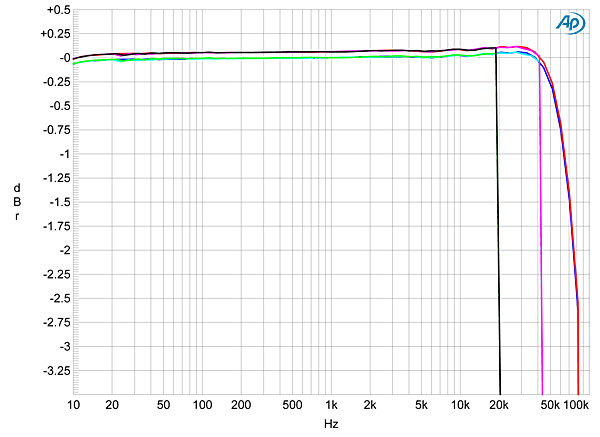
Fig.5 Musical Fidelity M6DAC, Fast filter, frequency response at –12dBFS into 100k ohms with data sampled at: 44.1kHz (left channel green, right gray), 96kHz (left cyan, right magenta), 192kHz (left blue, right red) (0.25dB/vertical div.).
I also looked at the spectrum of the M6DAC's output while it reproduced a dithered 1kHz tone at –90dBFS with both 16- and 24-bit data (fig.6, 1/3-octave analysis; fig.7, FFT analysis). With 16-bit data, all that can be seen, other than the spike peaking at exactly –90dBFS, is the spectrum of the dither used to encode the data. Increasing the bit depth to 24 drops the noise floor by 25dB in the treble, implying a resolution of at least 20 bits, which is superb, and easily enough to allow the M6DAC to resolve a 24-bit tone at –120dBFS (fig.6, bottom pair of traces). However, figs. 6 and 7 also show that the noise floor is a little higher in the right channel (dotted and red traces, respectively) in the midrange and below.
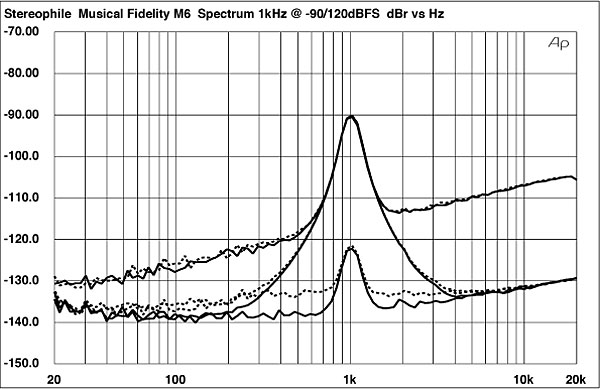
Fig.6 Musical Fidelity M6DAC, 1/3-octave spectrum with noise and spuriae of dithered 1kHz tone at –90dBFS with 16-bit data (top) and 24-bit data (middle), and at –120dBFS with 24-bit data (bottom) (right channel dashed).
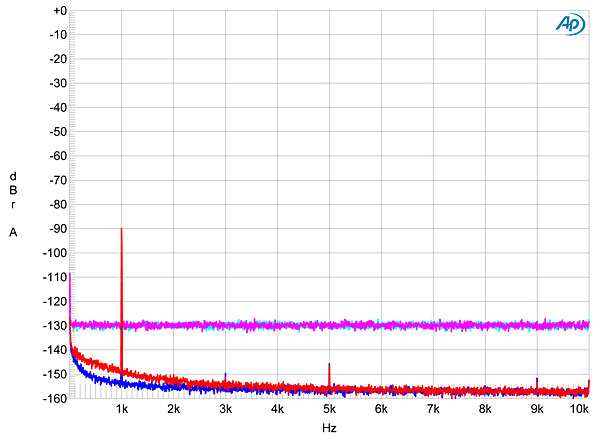
Fig.7 Musical Fidelity M6DAC, spectrum with noise and spuriae of dithered 1kHz tone at –90dBFS with: 16-bit data (left channel cyan, right magenta), 24-bit data (left blue, right red) (10dB/vertical div.).
These results were obtained with TosLink data; repeating the analysis with 24-bit USB data gave the same spectra as the blue and red traces in fig.7, confirming that the USB input does correctly handle 24-bit data. The Musical Fidelity's Bluetooth connection is restricted to 16-bit data; its performance will depend on whether the source device is capable of sending aptX-encoded data or is restricted to the older apt encoding. Neither my iPhone 3GS nor my iPad 2 offers aptX. The result with data representing a dithered tone at –90dBFS is a picket fence of distortion products, including one at half the signal frequency (fig.8). However, my 2012 MacBook Pro does offer aptX encoding, and linking this to the M6DAC both illuminated the aptX indicator in the latter's display and gave a much cleaner spectrum (fig.9). However, the level of the 1kHz tone is about 8dB too low in level, some distortion harmonics are visible, and the noise floor is closer to 15 bits than to the original data's 16 bits. Nevertheless, the aptX codec appears to be significantly better than the original apt.
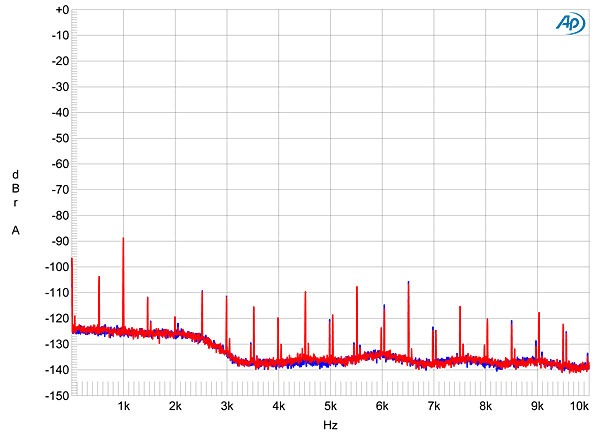
Fig.8 Musical Fidelity M6DAC, spectrum with noise and spuriae of dithered 1kHz tone at –90dBFS with 16-bit data sourced from iPad 2 via Bluetooth (left channel blue, right red) (10dB/vertical div.).
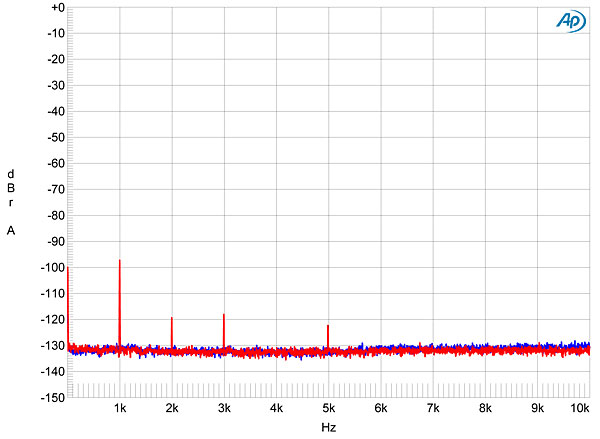
Fig.9 Musical Fidelity M6DAC, spectrum with noise and spuriae of dithered 1kHz tone at –90dBFS with 16-bit data sourced from MacBook Pro via Bluetooth (left channel blue, right red) (10dB/vertical div.).
Returning to PCM data: With D/A processors that use a sample-rate converter ahead of the DAC, there is always the possibility that mathematical limitations in the sample-rate converter chip will lead to some modulation of the noise floor; ie, the floor will be higher with signals that are themselves higher in level. But as fig.10 indicates, this was not the case with the M6DAC, where there was very little change in the level of the lower-frequency noise floor with a 1kHz tone at 0, –40, and –60dBFS. With that low level of noise and its superb resolution, the M6DAC's reproduction of an undithered tone at exactly –90.31dBFS was essentially perfect (fig.11), with a symmetrical waveform, the three DC voltage levels described by the data, and the digital filter's Gibbs Phenomenon "ringing" on the tops and bottoms of the waveform all well defined. With 24-bit data, the result was a superbly clean sinewave (fig.12).
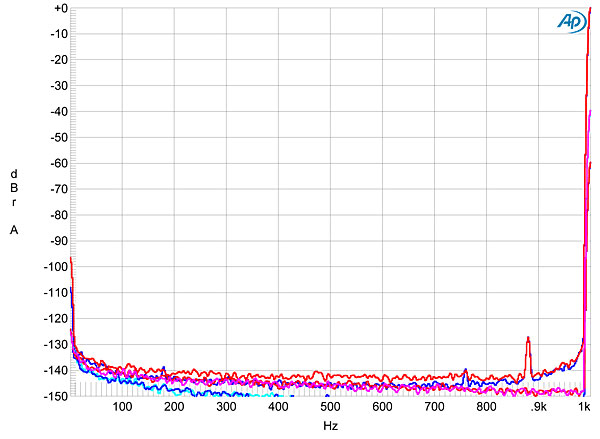
Fig.10 Musical Fidelity M6DAC, spectrum of 1kHz sinewave, DC–1kHz, at: 0dBFS (left channel blue, right red), –40dBFS (left cyan, right magenta), –60dBFS (left blue, right red) into 100k ohms (linear frequency scale).
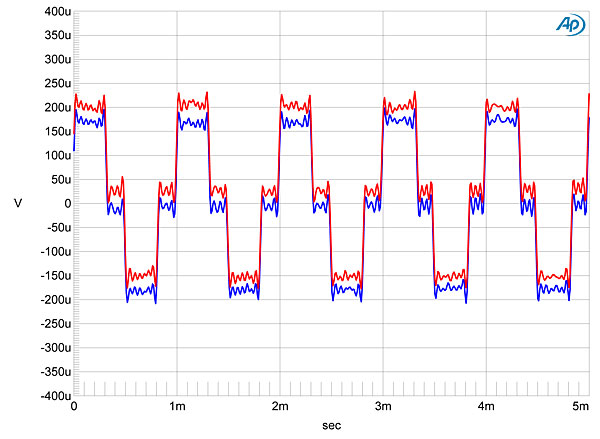
Fig.11 Musical Fidelity M6DAC, waveform of undithered 1kHz sinewave at –90.31dBFS, 16-bit data (left channel blue, right red).
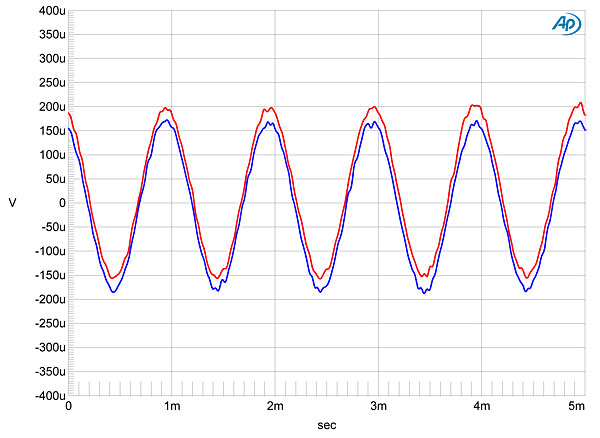
Fig.12 Musical Fidelity M6DAC, waveform of undithered 1kHz sinewave at –90.31dBFS, 16-bit data (left channel blue, right red).
Musical Fidelity's D/A processors have always offered low static distortion, and the M6DAC was no exception. Even into a punishing 600 ohm load, a full-scale 1kHz tone was reproduced with all the distortion harmonics at or below –100dB (0.001%), with the subjectively innocuous second and third harmonics highest in level (fig.13). This graph was taken with PCM data; with aptX data via Bluetooth (fig.14), no harmonics are visible, but the lossy encoding results in a rise in the noise floor to approximately the 10-bit level below 6kHz. With PCM data, the M6DAC offered superbly low levels of intermodulation distortion even into 600 ohms (fig.15), with only the 1kHz difference product rising above –110dB (0.0003%).
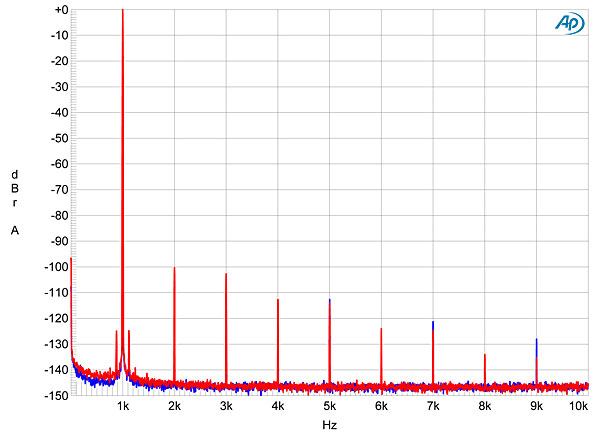
Fig.13 Musical Fidelity M6DAC, spectrum of 1kHz sinewave, DC–10kHz, at 0dBFS into 600 ohms, PCM data (left channel blue, right red; linear frequency scale).
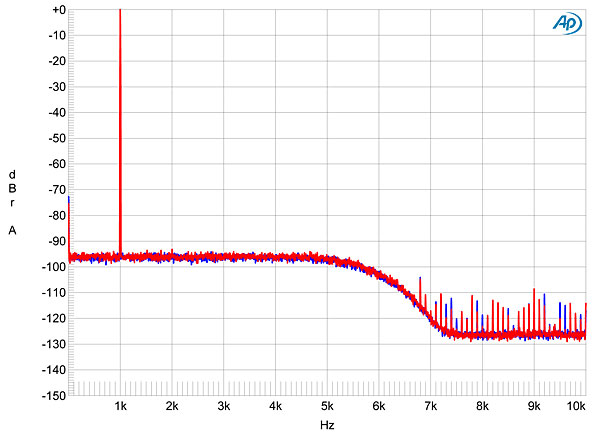
Fig.14 Musical Fidelity M6DAC, spectrum of 1kHz sinewave, DC–10kHz, at 0dBFS into 600 ohms, via Bluetooth from MacBook Pro (left channel blue, right red; linear frequency scale).
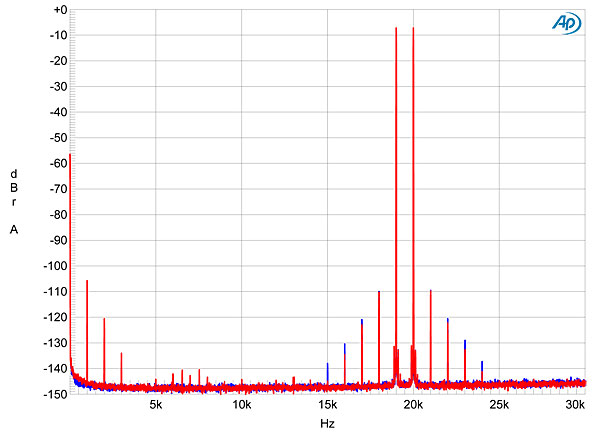
Fig.15 Musical Fidelity M6DAC, Fast filter, HF intermodulation spectrum, DC–30kHz, 19+20kHz at 0dBFS into 100k ohms (left channel blue, right red; linear frequency scale).
The M6DAC offered excellent jitter rejection via its TosLink, coaxial, AES/EBU, and USB inputs. The odd harmonics of the LSB-level squarewave component of the 16-bit J-Test signal lie at the residual level (fig.16) and are not accentuated by the DAC or its receiver circuitry. In this graph, however, a pair of sidebands can be seen at 120Hz to either side of a spectral spike representing the high-level tone at ¼ the sample rate. As these lie at the same level as the sidebands surrounding the 1kHz tone in fig.13, this suggests that they result from a low level of 120Hz hum on the DAC chips' voltage reference pin. (If the sidebands were due to jitter, they would fall in level as the frequency decreased.)
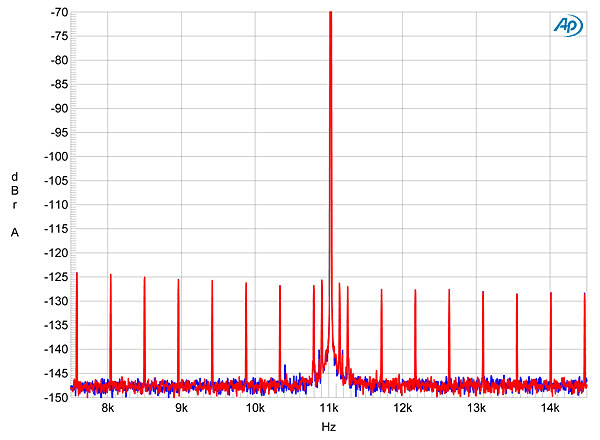
Fig.16 Musical Fidelity M6DAC, high-resolution jitter spectrum of analog output signal, 11.025kHz at –6dBFS, sampled at 44.1kHz with LSB toggled at 229Hz: 16-bit data via USB from MacBook Pro (left channel blue, right red). Center frequency of trace, 11.025kHz; frequency range, ±3.5kHz.
Sending 16-bit J-Test data to the Musical Fidelity via Bluetooth from my MacBook Pro gave the spectrum in fig.17. Though no jitter sidebands are visible, the aptX codec has raised the noise floor, again to the 10-bit level. With 24-bit data fed via USB, the noisefloor is very clean, other than again the sideband pair at ±120Hz (fig.18). The laptop was battery-powered for all these tests, by the way.
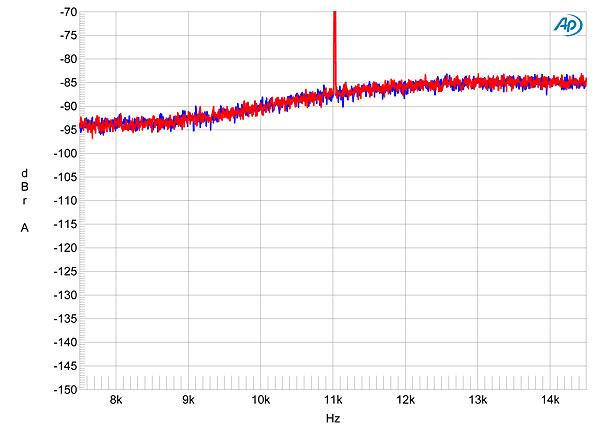
Fig.17 Musical Fidelity M6DAC, high-resolution jitter spectrum of analog output signal, 11.025kHz at –6dBFS, sampled at 44.1kHz with LSB toggled at 229Hz: 16-bit data via Bluetooth from MacBook Pro (left channel blue, right red). Center frequency of trace, 11.025kHz; frequency range, ±3.5kHz.
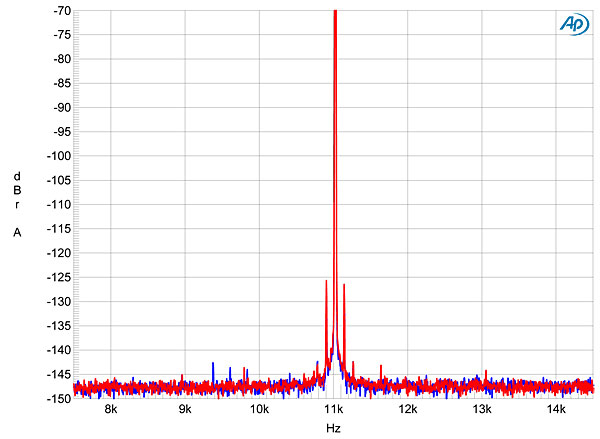
Fig.18 Musical Fidelity M6DAC, high-resolution jitter spectrum of analog output signal, 11.025kHz at –6dBFS, sampled at 44.1kHz with LSB toggled at 229Hz: 24-bit data via USB from MacBook Pro (left channel blue, right red). Center frequency of trace, 11.025kHz; frequency range, ±3.5kHz.
Other than that anomalous behavior with the Filter button, Musical Fidelity's M6DAC measured superbly, though it is fair to point out that it did not perform significantly better than Musical Fidelity's much-less-expensive M1DAC—setting aside, of course, the M6DAC's Bluetooth functionality and its ability to handle USB data sampled at up to 192kHz. And while I don't recommend the M6DAC's Bluetooth connection for serious listening, the lossy aptX codec appears to degrade the signal with relatively benign modulation of the noise floor rather than by adding quantizing noise and other mathematically related artifacts.—John Atkinson
- Log in or register to post comments




































